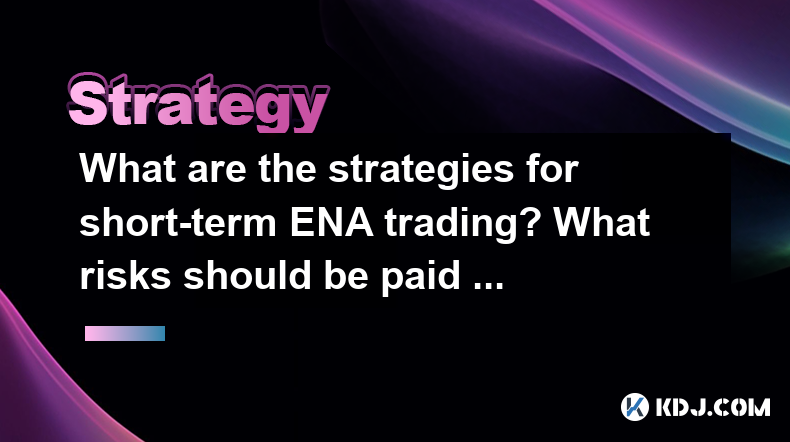-
 bitcoin
bitcoin $122025.899241 USD
-2.12% -
 ethereum
ethereum $4488.068729 USD
-4.11% -
 bnb
bnb $1315.348019 USD
8.65% -
 tether
tether $1.000457 USD
0.03% -
 xrp
xrp $2.875326 USD
-3.69% -
 solana
solana $222.043604 USD
-4.07% -
 usd-coin
usd-coin $0.999682 USD
0.00% -
 dogecoin
dogecoin $0.249887 USD
-5.62% -
 tron
tron $0.337379 USD
-2.59% -
 cardano
cardano $0.827763 USD
-5.06% -
 hyperliquid
hyperliquid $45.774531 USD
-2.43% -
 chainlink
chainlink $22.079309 USD
-5.87% -
 ethena-usde
ethena-usde $1.000156 USD
0.02% -
 sui
sui $3.482566 USD
-3.57% -
 stellar
stellar $0.386982 USD
-4.92%
What are the strategies for short-term ENA trading? What risks should be paid attention to in high-frequency operations?
Short-term ENA trading strategies include scalping and momentum trading, but high-frequency operations carry risks like market volatility and technical failures.
May 05, 2025 at 02:21 am

Short-term trading in the cryptocurrency market, specifically focusing on ENA, can be both lucrative and challenging. ENA, like many other cryptocurrencies, experiences high volatility, which can be exploited by traders aiming for quick profits. This article will delve into various strategies for short-term ENA trading and highlight the risks associated with high-frequency operations.
Understanding Short-Term Trading with ENA
Short-term trading, often referred to as day trading or swing trading, involves buying and selling ENA within a short timeframe, typically ranging from a few minutes to a few days. The primary goal is to capitalize on small price movements to generate profits. The key to successful short-term trading is a deep understanding of market trends, technical analysis, and risk management.
Technical Analysis for ENA Trading
Technical analysis is a crucial tool for short-term ENA traders. It involves analyzing historical price data and chart patterns to predict future price movements. Some of the commonly used technical indicators for ENA trading include Moving Averages, Relative Strength Index (RSI), and Bollinger Bands.
- Moving Averages: Traders often use the 50-day and 200-day moving averages to identify trends. When the short-term moving average crosses above the long-term moving average, it signals a potential bullish trend, and vice versa for a bearish trend.
- Relative Strength Index (RSI): The RSI helps identify overbought or oversold conditions. An RSI above 70 suggests that ENA might be overbought and due for a correction, while an RSI below 30 indicates it might be oversold and due for a rebound.
- Bollinger Bands: These bands help traders understand the volatility of ENA. When the price moves outside the upper or lower band, it may signal a potential reversal or continuation of the current trend.
Scalping: A High-Frequency Strategy
Scalping is a high-frequency trading strategy that involves making numerous trades within a single day to profit from small price changes. Scalpers aim to capture a few pips per trade, relying on the cumulative effect of these small gains to achieve significant profits.
To successfully scalp ENA, traders need to:
- Monitor the market closely: Scalping requires constant attention to the market, as opportunities can arise and disappear within seconds.
- Use tight stop-loss orders: Given the small profit margins, it's essential to limit potential losses by setting tight stop-loss orders.
- Leverage technology: Scalpers often use trading bots and algorithms to execute trades at high speed, ensuring they don't miss out on fleeting opportunities.
Momentum Trading with ENA
Momentum trading involves identifying and capitalizing on strong price movements in ENA. Traders look for stocks that are moving significantly in one direction on high volume, aiming to ride the momentum until it shows signs of reversal.
Key steps in momentum trading with ENA include:
- Identifying momentum: Use technical indicators like the Moving Average Convergence Divergence (MACD) to spot strong trends.
- Entering the trade: Buy ENA when it breaks out of a consolidation phase on high volume, indicating strong buying interest.
- Exiting the trade: Sell ENA when the momentum starts to fade, often signaled by a divergence between price and volume or a reversal in technical indicators.
Risk Management in Short-Term ENA Trading
Risk management is paramount in short-term trading, especially when dealing with a volatile asset like ENA. Traders must employ strategies to protect their capital and ensure they can continue trading even after experiencing losses.
Effective risk management techniques include:
- Setting stop-loss orders: Always set a stop-loss order to limit potential losses. For ENA, a common practice is to set the stop-loss at a level where the trade's initial thesis is invalidated.
- Position sizing: Determine the size of your ENA positions based on your overall trading capital and risk tolerance. Never risk more than a small percentage of your total capital on a single trade.
- Diversification: While focusing on ENA, consider diversifying across other cryptocurrencies to spread risk. This can help mitigate the impact of a significant drop in ENA's price.
Risks Associated with High-Frequency Operations
High-frequency trading, while potentially profitable, comes with its own set of risks that traders must be aware of. Understanding these risks is crucial for anyone engaging in high-frequency ENA trading.
- Market volatility: ENA's price can be extremely volatile, making high-frequency trades risky. Small price fluctuations can quickly turn profitable trades into losses.
- Slippage: High-frequency traders often face slippage, where the price at which a trade is executed differs from the expected price. This can erode profits, especially in a fast-moving market like ENA.
- Technical failures: High-frequency trading relies heavily on technology. Any technical glitch or connectivity issue can result in missed trades or unintended executions, leading to significant losses.
- Regulatory risks: The regulatory environment for cryptocurrencies is evolving. Changes in regulations could impact the ability to engage in high-frequency trading with ENA, potentially leading to legal or financial repercussions.
Frequently Asked Questions
Q: Can I use fundamental analysis for short-term ENA trading?A: While fundamental analysis can provide valuable insights into ENA's long-term potential, it is less effective for short-term trading. Short-term traders primarily rely on technical analysis to make quick decisions based on price movements and market trends.
Q: How much capital do I need to start short-term ENA trading?A: The amount of capital required depends on your trading strategy and risk tolerance. For high-frequency trading, you might need more capital to cover potential slippage and to take advantage of multiple trading opportunities. A common recommendation is to start with at least $1,000 to $5,000 to have enough flexibility in your trading.
Q: What are the best times to trade ENA for short-term gains?A: The best times to trade ENA for short-term gains are often during periods of high market activity, such as when major cryptocurrency exchanges are open. Typically, this includes the overlap of trading sessions in major markets like the US and Asia, which can lead to increased volatility and more trading opportunities.
Q: How can I improve my skills in short-term ENA trading?A: Improving your skills in short-term ENA trading involves continuous learning and practice. Consider the following steps:
- Educate yourself: Read books, take online courses, and follow reputable sources to enhance your understanding of technical analysis and trading strategies.
- Use a demo account: Many trading platforms offer demo accounts where you can practice trading ENA without risking real money.
- Analyze your trades: Keep a trading journal to review your trades, understand your mistakes, and refine your strategies over time.
- Stay updated: Keep abreast of market news and developments that could impact ENA's price, as staying informed can help you make better trading decisions.
Disclaimer:info@kdj.com
The information provided is not trading advice. kdj.com does not assume any responsibility for any investments made based on the information provided in this article. Cryptocurrencies are highly volatile and it is highly recommended that you invest with caution after thorough research!
If you believe that the content used on this website infringes your copyright, please contact us immediately (info@kdj.com) and we will delete it promptly.
- BlockDAG, DOGE, HYPE Sponsorship: Crypto Trends Shaping 2025
- 2025-10-01 00:25:13
- Deutsche Börse and Circle: A StableCoin Adoption Powerhouse in Europe
- 2025-10-01 00:25:13
- BlockDAG's Presale Buzz: Is It the Crypto to Watch in October 2025?
- 2025-10-01 00:30:13
- Bitcoin, Crypto, and IQ: When Genius Meets Digital Gold?
- 2025-10-01 00:30:13
- Stablecoins, American Innovation, and Wallet Tokens: The Next Frontier
- 2025-10-01 00:35:12
- NBU, Coins, and Crypto in Ukraine: A New Yorker's Take
- 2025-10-01 00:45:14
Related knowledge

Practical parameter settings for a Bitcoin multi-timeframe moving average system
Sep 18,2025 at 10:54pm
Optimizing Timeframe Combinations for Bitcoin Trading1. Selecting appropriate timeframes is crucial when building a multi-timeframe moving average sys...

How can I filter out false breakouts in Dogecoin high-frequency trading?
Sep 22,2025 at 01:00am
Understanding False Breakouts in Dogecoin Trading1. A false breakout occurs when Dogecoin's price appears to move beyond a defined support or resistan...

Techniques for identifying tops and bottoms in the Bitcoin on-chain NVT model
Sep 20,2025 at 07:54pm
Understanding the NVT Model in Bitcoin Analysis1. The Network Value to Transactions (NVT) ratio is often described as the 'P/E ratio' of the cryptocur...

What does the surge in open interest in Bitcoincoin futures mean?
Sep 20,2025 at 11:18pm
Understanding the Surge in Dogecoin Futures Open Interest1. A surge in open interest within Dogecoin futures indicates a growing number of active cont...

How can I use the Ethereum USDT premium to gauge market sentiment?
Sep 18,2025 at 11:55pm
Understanding the Ethereum USDT Premium1. The Ethereum USDT premium refers to the price difference between USDT (Tether) traded on Ethereum-based plat...

What should I do if Ethereum staking yields decline?
Sep 20,2025 at 06:18am
Understanding the Causes Behind Declining Ethereum Staking Yields1. The Ethereum network transitioned to a proof-of-stake consensus mechanism with the...

Practical parameter settings for a Bitcoin multi-timeframe moving average system
Sep 18,2025 at 10:54pm
Optimizing Timeframe Combinations for Bitcoin Trading1. Selecting appropriate timeframes is crucial when building a multi-timeframe moving average sys...

How can I filter out false breakouts in Dogecoin high-frequency trading?
Sep 22,2025 at 01:00am
Understanding False Breakouts in Dogecoin Trading1. A false breakout occurs when Dogecoin's price appears to move beyond a defined support or resistan...

Techniques for identifying tops and bottoms in the Bitcoin on-chain NVT model
Sep 20,2025 at 07:54pm
Understanding the NVT Model in Bitcoin Analysis1. The Network Value to Transactions (NVT) ratio is often described as the 'P/E ratio' of the cryptocur...

What does the surge in open interest in Bitcoincoin futures mean?
Sep 20,2025 at 11:18pm
Understanding the Surge in Dogecoin Futures Open Interest1. A surge in open interest within Dogecoin futures indicates a growing number of active cont...

How can I use the Ethereum USDT premium to gauge market sentiment?
Sep 18,2025 at 11:55pm
Understanding the Ethereum USDT Premium1. The Ethereum USDT premium refers to the price difference between USDT (Tether) traded on Ethereum-based plat...

What should I do if Ethereum staking yields decline?
Sep 20,2025 at 06:18am
Understanding the Causes Behind Declining Ethereum Staking Yields1. The Ethereum network transitioned to a proof-of-stake consensus mechanism with the...
See all articles










































































